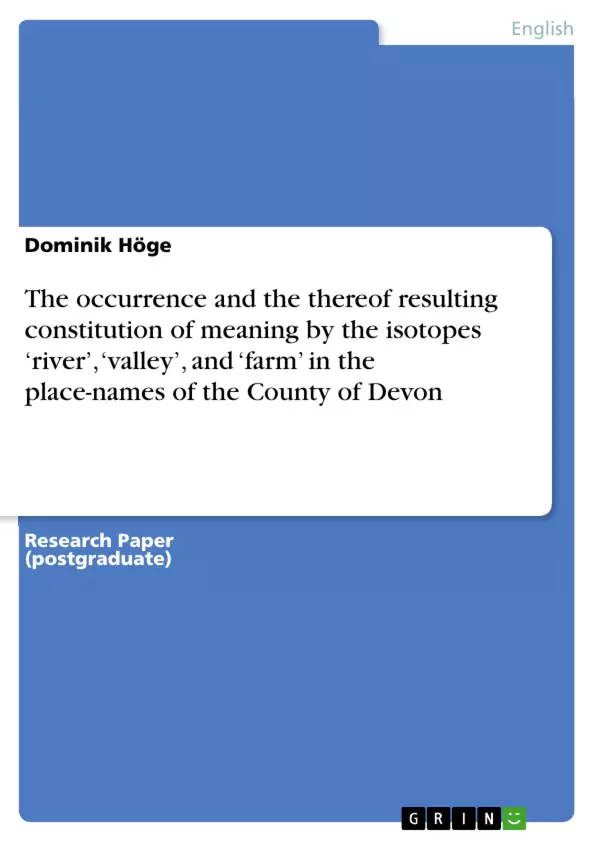Place-name research, or in other words called toponymy, within the field of onomastics, is one of the fastest growing domains in linguistics which brings new light and a different perspective to the study of language and words for which reason it has been subject to intense linguistic debates. In accordance with linguistic, historical, and geographical research matters, it investigates the etymology of city, town, field, and street names whose roles have always been to help identify and distinguish places from one another. Most settlement-names originated as descriptions that intended to identify individual places and to record information, for instance, about ownership or legal status. Subsequently, incorporating topographical elements in place-names has always been common practice, and according to Cole, these elements have been consistently applied throughout the history of English place-names. This is because all kinds of travellers, traders, kings with its courts, and people in general travelled across the world notwithstanding their illiteracy. Hence, written directions would have been of little use so that place-names were rather named after geographical entities (such as rivers, lakes, valleys, bays, or promontories) and towns or places within routes were named in the sense of “a list of places to pass through” (such as farms, farmsteads, farmlands, woodlands, or manufactures) so that travellers could go along this “list” to reach their destination.
Inhaltsverzeichnis (Table of Contents)
- Introduction and theoretical background
- Methodology
- Results
- Discussion and Conclusion
- References
- Appendix
Zielsetzung und Themenschwerpunkte (Objectives and Key Themes)
This study delves into the history of English place-names, specifically focusing on the isotopes "river," "valley," and "farm" in the place-names of the County of Devon. It aims to investigate the etymology of these place-names, analyze their semantic content, and determine if there are any consistent patterns in their meanings. This analysis draws upon linguistic, historical, and geographical perspectives, providing insights into how these isotopes have shaped the English language and how they have been utilized in place-name formation.
- The role of geographical entities in place-name formation.
- The semantic content of the isotopes "river," "valley," and "farm" in Devon place-names.
- The impact of linguistic conventions on place-name meanings.
- The methodology of place-name research and its application in the study of Devon place-names.
- The historical development of English place-names, particularly within the context of the English Place-Names Society's "Survey of English Place-Names."
Zusammenfassung der Kapitel (Chapter Summaries)
- Introduction and theoretical background: This chapter sets the stage for the study by introducing the field of place-name research (toponymy) and its significance within the broader context of linguistics. It discusses the historical and geographical factors that contribute to the development of place-names and the importance of incorporating topographical elements in naming practices. The chapter concludes by introducing the three semantic fields – "river," "valley," and "farm" – that will be the focus of the study.
- Methodology: This chapter details the methodology used for conducting the study. It outlines the specific region chosen (Devon) and its geographical characteristics. The chapter also describes the process of identifying and categorizing place-names containing the isotopes of interest. The research tools, including A.D. Mills' "A Dictionary of British Place-names," are discussed alongside potential challenges and limitations of the study.
- Results: This chapter presents the findings of the study, focusing on the proportion of place-names in Devon that feature at least one of the three isotopes. The results highlight the frequency of each isotope ("river," "valley," and "farm") within the chosen corpus, providing a quantitative analysis of the data.
Schlüsselwörter (Keywords)
Key terms and topics explored in this study include toponymy, place-name research, English language, historical linguistics, geographical factors, semantic content, etymology, isotopes, "river," "valley," "farm," County of Devon, and the "Survey of English Place-Names."
- Quote paper
- Dominik Höge (Author), 2022, The occurrence and the thereof resulting constitution of meaning by the isotopes ‘river’, ‘valley’, and ‘farm’ in the place-names of the County of Devon, Munich, GRIN Verlag, https://www.grin.com/document/1481906



